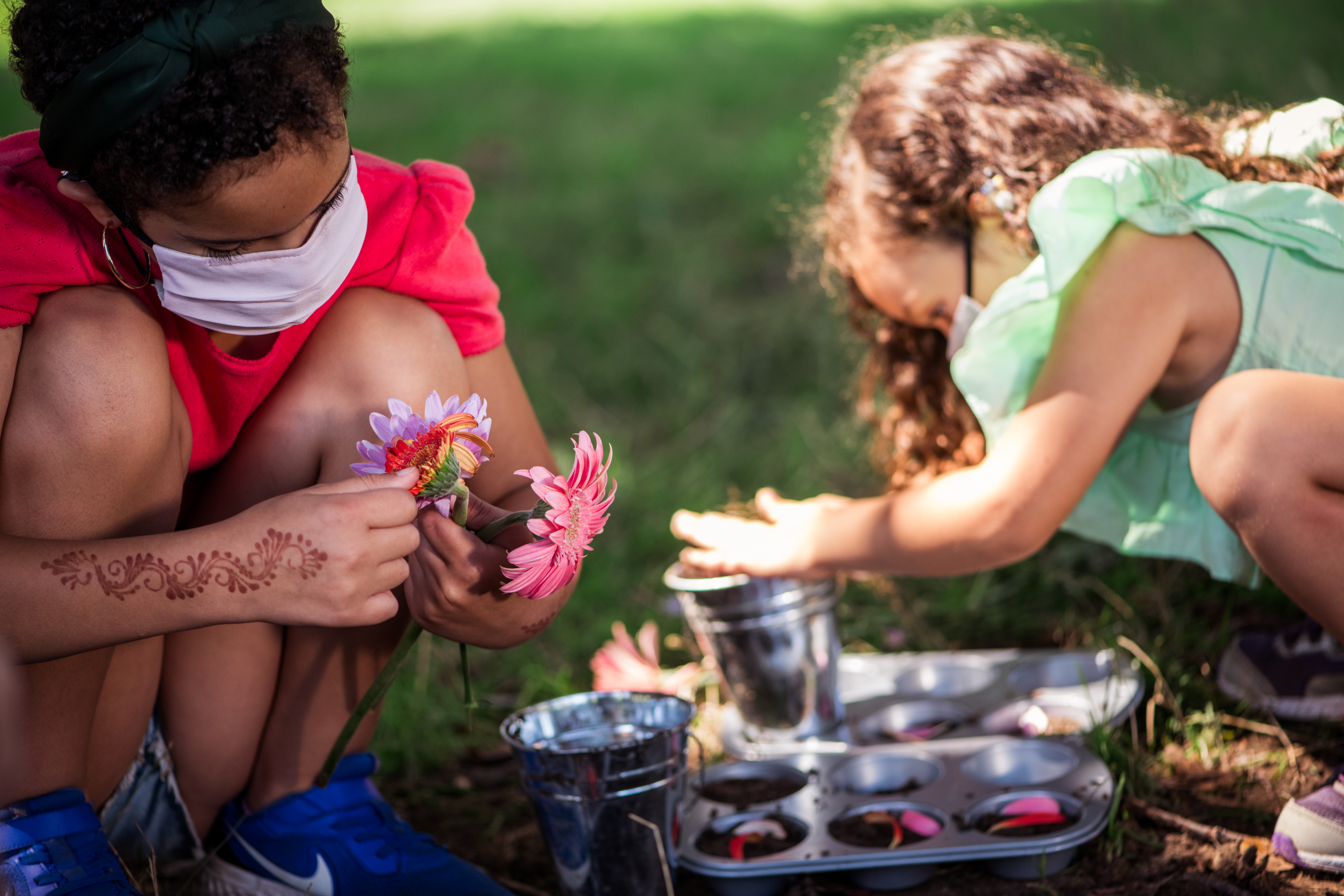If someone had told me in March, 2020 that I’d spend the coming year and a half developing ways for young children to keep their distance while they play and connect together, mask up or gathering kids online to help them learn outdoors, I wouldn’t have believed it. But, these have been incredible times, and shifting realities have changed the game.
Now, these things feel imperative. And, they've made all the difference for so many families.
My father has a saying: “What’s real isn’t always what’s ideal, and what’s ideal is rarely real.”
I’ve never felt it more applicable or helpful than while parenting and educating during COVID-19. Things are not ideal in many, fundamental ways, and yet here we are. Though hopefully not forever, this is our reality.
This begs big questions for parents and educators alike—do we anchor on what is ideal or on what is real as we support our kids during such a wild time? Do we hold kids precious and protect them from this reality, or do we help them to navigate within and adapt to it? Which will help them to thrive more in the long term?
My vote: Let go of “ideal” and parent for real.
In any given moment we have two options: to step forward into growth or to step back into safety. —Abraham Maslow
Kids will roll with it if you let them
Humans—especially wee ones—are naturally quite resilient, adaptable and hopeful. Kids don’t rage against reality like we adults often do—they tend to roll with things, especially if we give them the OK and support to do so.
My oldest was born with a club foot, and I was totally overwhelmed when her doctor told us 10 month old Maeve had to wear special boots locked together with a metal bar—all day long. My heart ached for my speedy crawler the first day I set her down on the floor, and it sank when another mom dropped a “so sorry!” on me at music class later that same day. This was not ideal. I called the orthopedist and implored him to find another way, but he insisted she would be fine, and that this was what she really needed.
How did Maeve react? As I was freaking out, she was moving from puzzled to frustrated to “I got this.” Within a day, she figured out how to make life work with her new constraint. Today, it’s clear this kid was born to run. Maybe even more powerfully, Maeve is persistent and confident—and I have no doubt that navigating this challenge early on contributed to that. It’s wild to think of all she would have missed if I had insisted on saving her from what felt so hard for her in that moment instead of supporting what she really needed.
Kids don’t suffer the loss of the ideal
Many people have leaned into this new normal and brought their children along, showing them how to learn new ways of doing things and making this new reality work—just like Maeve and her boots and bar. On the other hand, equally caring adults have grown fiercely attached to an ideal view of life for kids.
For example, some have said that it’s terrible to ask a 3-year-old to wear a mask, or for a child to see their teacher or parent wear a mask. It’s true that covering such an important part of the face is not ideal—we learn so much from seeing the many facial muscles blocked by our masks at work. A recent study has shown that pandemic, in totality, has not had a positive impact on certain aspects of early learning. But, those studies were not designed to evaluate which aspect of pandemic life—including masks—drove kids' delays. More importantly, if balanced amounts of mask-wearing provides for a child’s safety and enables them to connect in person with kids and adults outside of their family, it feels well worth the risk.
Some 3-year-olds also struggle at first and need time to make friends with masks. But with practice, nearly every little kid I’ve seen takes to it just fine—and there are many ways to make mask wearing feel normal and fun for kids. I have also observed kids adjust quite quickly to the masks around them, learning to see a smile reflected in someone’s eyes or to use thumbs up or down to communicate feelings. Plus, learning to wear the mask teaches kids that they can adapt.
I’ve also heard people say that it’s psychologically damaging to ask a child to keep social distance from a friend or loved one. For sure, it feels neither natural nor easy for kids to hold back from being close and even embracing one another or their elders. Again, as an early childhood educator, I would certainly not advise it under normal circumstances. That desire to touch is a sweet feature of our early days on the planet. It is also understandable to find it easier not to ask kids to even try, especially if you live in a place where you may be judged when your child needs reminders or practice.
But is it really damaging to ask kids to learn to keep close to family while keeping a six-foot bubble from others? Really? The alternative to asking kids to learn to keep social distance can mean isolation from friends and family, lost chances to be among other people and feel part of a community. Is that a better option? And, what lesson does avoiding these social encounters teach our kids?
Distancing with kids is doable
There are many ways to make six feet feel connected and sweet. Our family loves to give air hugs, and we practice with grandparents, with friends and even at Tinkergarten. Others have made up special waves or focused on hugging stuffed animals or pillows until we can hug the real people again.
We don’t need to tell kids that getting close is “bad” or “dangerous” for them to learn to keep distance. At Tinkergarten, we talk to kids about “keeping our six-foot bubble to “keep everyone safe,” rather than use fear of the virus. It is a loving and caring act to preserve your friend’s bubble, and little kids can really get behind that idea.
These lessons are not new
Teaching kids to “keep each other safe” is nothing new for us at Tinkergarten. Take stick play, for example. When kids play with sticks there is real danger that a child could poke himself or another child. We adults have two choices—take all of the sticks away or make some simple rules for the sticks like, “sticks need space” or “sticks can touch all kinds of things, but NOT another friend’s body.” Removing all danger is easier on adults for sure, but kids lose out on learning so many lessons and the joy of stick play! If you continue to gently remind kids of the rules, eventually they’ve got them.
Kids need reminders
Gentle reminders are our powerful tool. Little kids do not have strong impulse control, so it takes reminding them and reminding them and reminding them. But, that is just how little kids learn—through repetition. If you can make the reminders fun, shame-free and kid-centered, it’s actually enjoyable to teach and watch your kids learn to mind their space bubble. For example, we love playing like lobsters at Tinkergarten—backing up just a bit to help kids learn to keep their space bubbles in place.
Choosing the "ideal" is often a privilege.
It is a privilege to advocate for what is ideal for your children—an option that not all parents have. No matter how you feel about the new normal, we need to work hard, listen and dig in to understand the benefits and risks of different ways of learning for kids before we speak out against them on principle.
“Challenges are gifts that force us to search for a new center of gravity. Don’t fight them. Just find a new way to stand.” – Oprah Winfrey
So much of how our kids adapt to new challenges is how we present and respond to those challenges. That has never been more true than it is now. Let’s never lose sight of what is ideal. Let’s agree to look forward to days when it’s easier, more natural and more free to let our kids be and play like kids have long been able to do. But, let’s not let the ideal be the enemy of all of the good lessons and good chances to be together that are real in this moment. See you outside!

